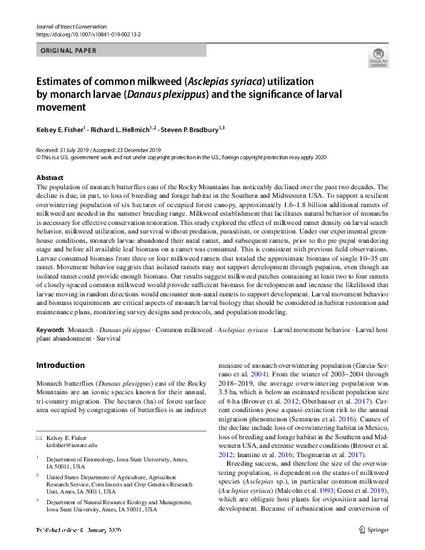
The population of monarch butterflies east of the Rocky Mountains has noticeably declined over the past two decades. The decline is due, in part, to loss of breeding and forage habitat in the Southern and Midwestern USA. To support a resilient overwintering population of six hectares of occupied forest canopy, approximately 1.6–1.8 billion additional ramets of milkweed are needed in the summer breeding range. Milkweed establishment that facilitates natural behavior of monarchs is necessary for effective conservation restoration. This study explored the effect of milkweed ramet density on larval search behavior, milkweed utilization, and survival without predation, parasitism, or competition. Under our experimental greenhouse conditions, monarch larvae abandoned their natal ramet, and subsequent ramets, prior to the pre-pupal wandering stage and before all available leaf biomass on a ramet was consumed. This is consistent with previous field observations. Larvae consumed biomass from three or four milkweed ramets that totaled the approximate biomass of single 10–35 cm ramet. Movement behavior suggests that isolated ramets may not support development through pupation, even though an isolated ramet could provide enough biomass. Our results suggest milkweed patches containing at least two to four ramets of closely-spaced common milkweed would provide sufficient biomass for development and increase the likelihood that larvae moving in random directions would encounter non-natal ramets to support development. Larval movement behavior and biomass requirements are critical aspects of monarch larval biology that should be considered in habitat restoration and maintenance plans, monitoring survey designs and protocols, and population modeling.
Available at: http://works.bepress.com/richard_hellmich/199/

This article is published as Fisher, Kelsey E., Richard L. Hellmich, and Steven P. Bradbury. "Estimates of common milkweed (Asclepias syriaca) utilization by monarch larvae (Danaus plexippus) and the significance of larval movement." Journal of Insect Conservation (2020). doi: 10.1007/s10841-019-00213-2.